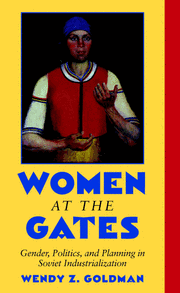Book contents
- Frontmatter
- Contents
- Acknowledgments
- List of Illustrations
- List of Tables
- Acronyms and Abbreviations
- Women at the Gates
- Introduction
- 1 Guarding the Gates to the Working Class: Women in Industry, 1917–1929
- 2 The Struggle over Working-Class Feminism
- 3 The Gates Come Tumbling Down
- 4 From Exclusion to Recruitment
- 5 “The Five-Year Plan for Women”: Planning Above, Counterplanning Below
- 6 Planning and Chaos: The Struggle for Control
- 7 Gender Relations in Industry: Voices from the Point of Production
- 8 Rebuilding the Gates to the Working Class
- Conclusion
- Index
- Plate Section
4 - From Exclusion to Recruitment
Published online by Cambridge University Press: 30 July 2009
- Frontmatter
- Contents
- Acknowledgments
- List of Illustrations
- List of Tables
- Acronyms and Abbreviations
- Women at the Gates
- Introduction
- 1 Guarding the Gates to the Working Class: Women in Industry, 1917–1929
- 2 The Struggle over Working-Class Feminism
- 3 The Gates Come Tumbling Down
- 4 From Exclusion to Recruitment
- 5 “The Five-Year Plan for Women”: Planning Above, Counterplanning Below
- 6 Planning and Chaos: The Struggle for Control
- 7 Gender Relations in Industry: Voices from the Point of Production
- 8 Rebuilding the Gates to the Working Class
- Conclusion
- Index
- Plate Section
Summary
We must broaden the circle of registration of the unemployed to include those who have not had the right to register with the organs of labor up to this time.
Decree on registration, May 10, 1930We need to spend the minimum on housing to guarantee the maximum tempo of industrialization. This can be done only if we maximize the labor resources of the present urban population and those in the new towns. This means the maximum involvement of women.
L. Sabsovich, planner, 1930Throughout 1930 and 1931, labor officials struggled to apprehend and gain control of the vast changes taking place in the economy. Employees in the labor exchanges (birzhi truda) stood in the front line of the transformation, desperately trying to create order out of chaos. Caught between the insistent demands of managers for labor and the hordes of incoming workers on the one hand, and an increasingly obsolete labor policy on the other, they were largely ineffective in their efforts to direct and deploy the labor force. As labor shortages rapidly replaced unemployment, the state was forced to replace a policy based on exclusion with a scheme for recruitment. The Commissariat of Labor (NKT) was confronted with the new and difficult tasks of understanding, directing, and mastering the roiling waves of movement and migration stirred up by collectivization, the socialization of retail trade, and industrialization.
- Type
- Chapter
- Information
- Women at the GatesGender and Industry in Stalin's Russia, pp. 109 - 142Publisher: Cambridge University PressPrint publication year: 2002



